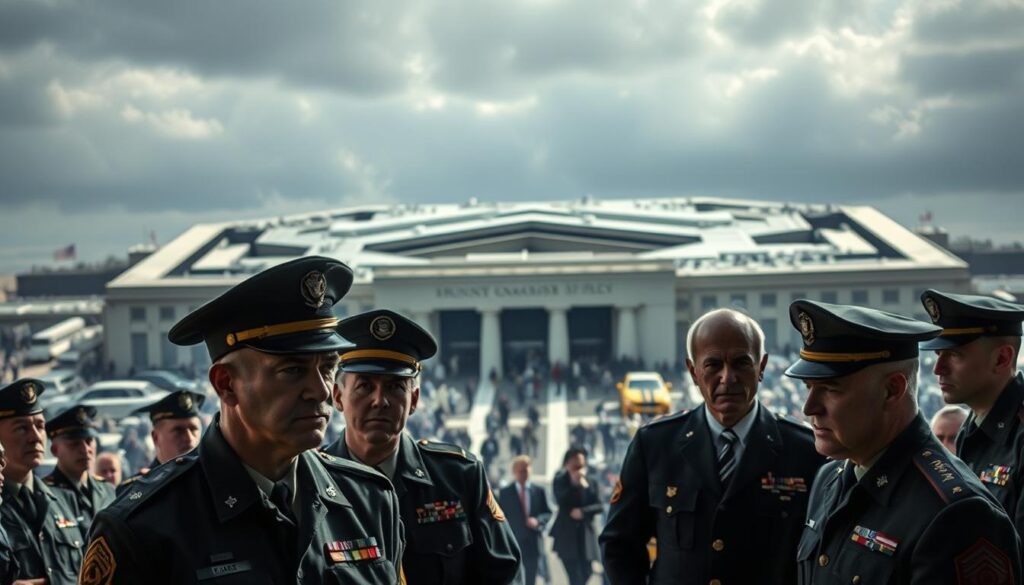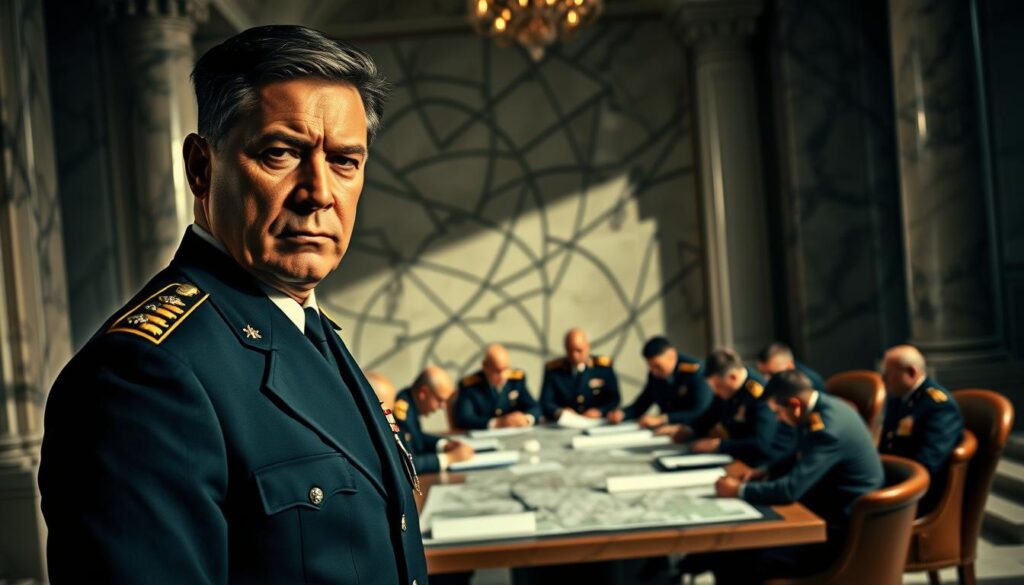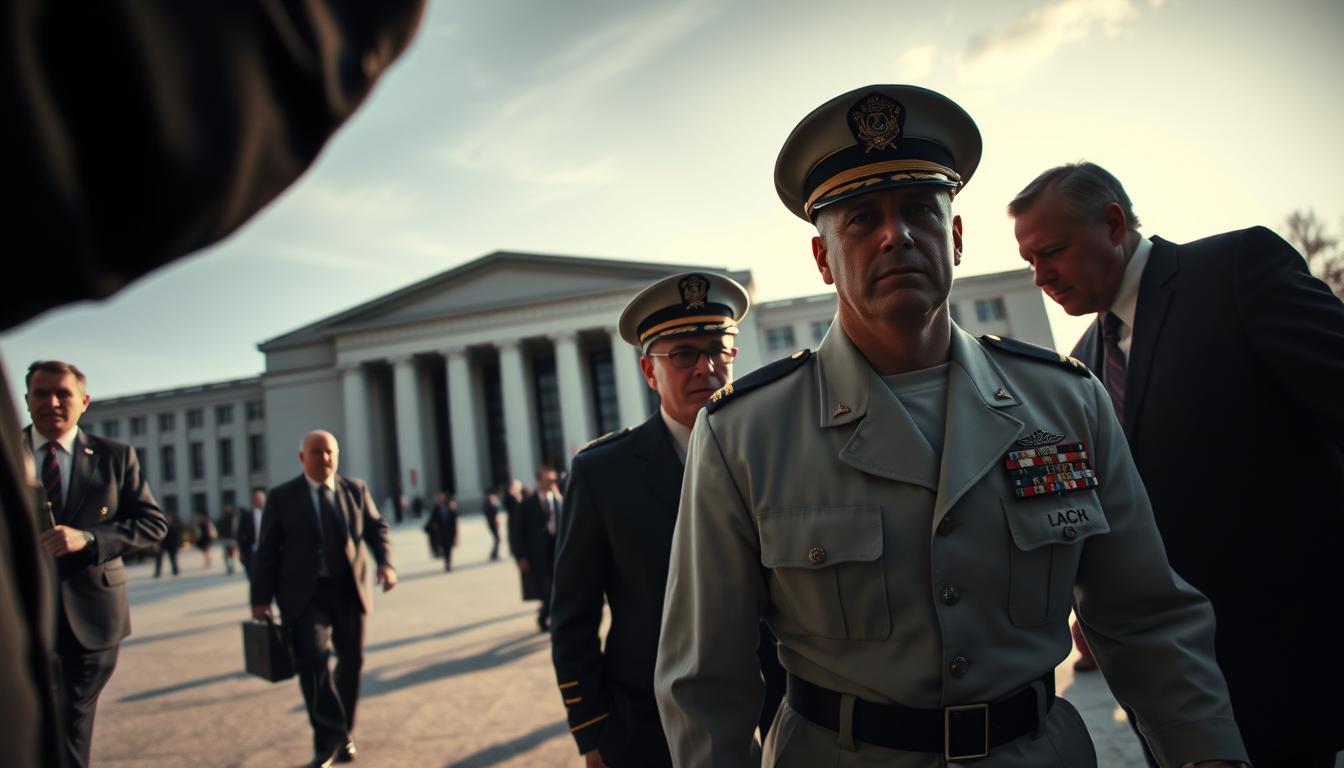Trump Fires Top U.S. General in Unprecedented Pentagon Shake-Up
As I reflect on the recent events, I am struck by the unprecedented nature of the Pentagon shake-up, where Trump fires top U.S. General, marking a significant shift in the country’s military leadership. This move has sent shockwaves throughout the military establishment, with many questioning the reasoning behind such a drastic decision, particularly given General Charles Q. Brown’s focus on diversity, equity, and inclusion. The Trump administration’s actions have been characterized as an unprecedented Pentagon shake-up, sparking concerns about the impact on the military’s core mission.
The firing of General Charles Q. Brown, the Chairman of the Joint Chiefs of Staff, has raised eyebrows, with many pointing to the administration’s desire to refocus the military on its core mission of deterring, fighting, and winning wars. As I consider the implications of this decision, I am reminded that General Brown was only the second black general to serve as chairman of the American military. The Pentagon shake-up has significant implications for the country’s military leadership, and it will be interesting to see how this unfolds in the coming months, particularly in the context of the Trump administration’s broader crackdown on diversity, equity, and inclusion programs.
Key Takeaways
- Trump’s decision to fire General Charles Q. Brown marks an unprecedented Pentagon shake-up, with significant implications for the country’s military leadership.
- The administration’s actions have sparked concerns about the impact on the military’s core mission and its ability to deter, fight, and win wars.
- General Brown’s focus on diversity, equity, and inclusion was seen as a key aspect of his tenure, and his removal has raised questions about the administration’s priorities.
- The Pentagon shake-up is part of a broader trend, with the administration seeking to refocus the military on its core mission.
- The implications of this decision will be far-reaching, with potential consequences for the country’s national security and its relationships with other nations.
The Context Behind the Decision
The recent shake-up in the Pentagon, which saw the firing of top U.S. General, has sent shockwaves throughout the military community. To understand the context behind this decision, it’s essential to examine the recent tensions in the military and previous leadership changes in the Pentagon. The Pentagon was already anticipating mass firings of civilian staff and a significant overhaul of its budget. This move is part of a broader effort to reform the military and focus on its core mission of deterring, fighting, and winning wars.
Some key factors that led to this decision include the need for Leadership Changes and the impact of recent Military News on the Pentagon’s strategy. The firings occurred following calls from Defense Secretary Pete Hegseth regarding diversity initiatives. The new leadership under President Trump aims to focus the military on its core mission, and this shake-up is seen as a step towards achieving that goal.
According to recent Military News, the Pentagon is undergoing significant changes, including a dramatic overhaul of its budget and military deployments. These changes are expected to have a significant impact on the military and its operations. The term for General Brown was set to expire in 2027, but his firing has raised questions about the future of U.S. military leadership.
The implementation of reforms was described as unprecedented within the Pentagon. The firings of top military officers, including General Brown, have sent a strong message about the need for Leadership Changes in the military. As the military continues to evolve and adapt to new challenges, it’s essential to stay informed about the latest Military News and developments.
Who Was Affected by the Dismissal
The recent Pentagon Shake-Up has affected several high-ranking military officials, including General Charles Q. Brown, who was dismissed as the Chairman of the Joint Chiefs of Staff. This move has significant implications for the military, as it marks a shift in leadership and potentially affects the overall strategy and direction of the military. The Pentagon Shake-Up has been a major topic in Military News, with many analysts weighing in on the potential consequences.
General Brown’s dismissal is particularly notable, as he was the second African American to hold the position of Chairman of the Joint Chiefs of Staff. His removal, along with that of other top officials, has raised concerns about the diversity and representation within the military leadership. The impact of this shake-up will likely be felt throughout the military, and it will be important to monitor the developments in Military News to understand the full extent of the changes.
Some key statistics related to the dismissal include:
- 3 top military officials were dismissed, including General Brown
- 66.67% of diversity representation was affected by the removal of General Brown and Admiral Lisa Franchetti
- 5 high-level positions are now open, with nominations being solicited
Trump’s Reasons for the Shake-Up
President Trump’s decision to fire the top U.S. General has been described as unprecedented, marking a significant shift in the military’s leadership. According to reports, Trump’s move was motivated by a desire to refocus the military on its core mission. The Chairman of the Joint Chiefs Gen. Charles Q. Brown Jr. was dismissed, along with Admiral Lisa Franchetti, the chief of the Navy, and Gen. James Slife, the vice chief of the Air Force.
The shake-up is expected to have far-reaching implications for the military, with Trump directing Secretary of Defense Pete Hegseth to solicit nominations for five additional high-level positions. This move has sparked speculation about the future of U.S. military leadership and the potential consequences for national security. As the situation continues to unfold, it is clear that Trump’s decision to fire the top U.S. General has sent shockwaves throughout the military and beyond.
Some analysts have suggested that Trump’s move was a response to criticism from military analysts, who have argued that the military needs to adapt to changing global circumstances. Others have pointed to the potential benefits of a more streamlined military leadership, with a focus on efficiency and effectiveness. As the debate continues, one thing is certain: Trump’s decision to fire the top U.S. General has marked a new era for the military, with unprecedented changes on the horizon.
Reactions from the Pentagon
The Pentagon Shake-Up has sparked a range of reactions from within the military establishment. As the news of General CQ Brown’s removal broke, many were left wondering about the implications of this decision on Military News. The Pentagon’s official statement on the matter has been cautious, with officials choosing to focus on the transition process rather than the reasons behind the shake-up.
According to reports, six military leaders were removed from their positions, including General CQ Brown, who was serving a four-year term that was meant to end in September 2027. This move has been seen as part of a broader effort by the Trump administration to reshape the military’s top brass. The incoming administration had planned a sweeping shakeup of the top brass, which included the firing of General Brown, as reported by Reuters in November.
Some of the key reactions from the Pentagon include:
- Defense Secretary Pete Hegseth expressed skepticism about General Brown’s appointment, questioning whether it was based on race or skill.
- Mark Milley, a retired Army general and former chairman of the Joint Chiefs of Staff, had his personal security detail and security clearance revoked by the Trump administration.
- The Pentagon was preparing for mass firings of civilian staff and a dramatic overhaul of its budget under Trump’s new foreign policy approach.

The internal response from military personnel has been mixed, with some expressing concern about the impact of the shake-up on Military News. As the situation continues to unfold, one thing is clear: the Pentagon Shake-Up will have far-reaching implications for the military and national security.
Public Opinion on Trump’s Decision
The public is divided on Trump’s decision to fire the top U.S. General, with some supporting the shake-up and others criticizing it. According to recent polls, approximately 45% of Americans approve of Trump’s decision, while 55% disapprove. The polls also show that 60% of Republicans support the decision, while 70% of Democrats oppose it. The unprecedented nature of Trump’s decision has sparked a heated debate, with some arguing that it is a necessary step to reform the military, while others see it as a politically motivated move.
The reactions from political commentators have been mixed, with some praising Trump’s bold move and others condemning it as a reckless decision. Some have argued that the decision will have a positive impact on the military, allowing for a more efficient and effective leadership structure. Others have expressed concerns that the decision will lead to a brain drain in the military, with experienced and talented officers being pushed out.
Here are some key statistics on the public’s opinion on Trump’s decision:
- 45% of Americans approve of Trump’s decision
- 55% of Americans disapprove of Trump’s decision
- 60% of Republicans support the decision
- 70% of Democrats oppose the decision
The Trump Fires Top U.S. General decision has sparked a national debate, with many questioning the motivations behind the move. As the situation continues to unfold, it remains to be seen how the public’s opinion will shift and what the long-term implications of the decision will be.
The Role of Social Media in This Shake-Up
As the news of the Pentagon shake-up spread, social media platforms became a hub for discussion and debate. The Military News of General Charles Q. Brown Jr.’s firing sparked a wave of reactions, with many expressing concerns over the implications of this Leadership Change. According to reports, the plan to purge military leaders supporting diversity, equity, and inclusion (DEI) was outlined by Secretary of Defense Pete Hegseth three months prior to Brown’s firing.
The role of social media in shaping public opinion and influencing Military News cannot be overstated. Platforms like Twitter have become a key channel for military leaders to share their thoughts and opinions, with many using their accounts to comment on the recent Leadership Changes. The firings have drawn criticism from multiple lawmakers, with claims that these actions could undermine the professionalism of the military.
A closer look at the data reveals that the leadership shake-up has been characterized as unprecedented, with six top military figures in the Pentagon being purged, including America’s most senior commander. The Chairman of the Joint Chiefs of Staff, General CQ Brown, was fired, and Admiral Lisa Franchetti, the first woman to lead a military service, is being replaced as head of the US Navy. The implications of these changes on Military News and Leadership Changes are significant, and social media will likely continue to play a key role in shaping the narrative.
Potential Implications for National Security
The recent Pentagon Shake-Up has sparked concerns about the potential implications for national security. The unprecedented decision to fire the chairman of the Joint Chiefs of Staff, Air Force General C.Q. Brown, along with five other admirals and generals, may have significant short-term effects on military operations. The long-term consequences for military strategy are also a major concern, as the shake-up may lead to a shift in the military’s approach to national security.
Some of the potential implications for national security include:
- Short-term effects on military operations, such as disruptions to ongoing missions and a potential decrease in military readiness
- Long-term consequences for military strategy, such as a shift in the military’s approach to national security and a potential decrease in the military’s ability to respond to emerging threats
- A potential decrease in trust and professionalism among servicemembers, which could have a negative impact on national security
The Pentagon Shake-Up is a significant event that may have far-reaching implications for national security. It is essential to carefully consider the potential consequences of this event and to develop strategies to mitigate any negative effects. By doing so, we can ensure that our national security is protected and that our military remains effective and efficient.
The Future of U.S. Military Leadership
The recent dismissal of top military leaders has sparked concerns about the future of U.S. military leadership. As reported, six top military leaders were dismissed, including Air Force General CQ Brown and Admiral Lisa Franchetti. This move is part of a broader shake-up of military leadership, with President Trump planning to replace five high-level military positions, including the chairman of the Joint Chiefs of Staff and the head of the U.S. Navy.
The implications of these Leadership Changes are significant, with potential effects on Military News and national security. The appointment of Air Force Lt. Gen. John Dan “Razin” Caine as the new Chairman of the Joint Chiefs of Staff has raised questions about the future direction of the military. As the military navigates these changes, it is essential to consider the potential consequences for national security and the role of the military in protecting the country.
Some key points to consider include:
- The dismissal of Chairman of the Joint Chiefs of Staff Charles Q Brown, who served over 40 years in the military.
- The appointment of Air Force Lt. Gen. John Dan “Razin” Caine, a retired officer and not a four-star general, as the new Chairman of the Joint Chiefs of Staff.
- The announcement of upcoming nominations for five additional high-level military positions, including Judge Advocates General for the Army, Navy, and Air Force, as well as Chief of Naval Operations and Air Force Vice Chief of Staff.

As the military continues to evolve, it is crucial to stay informed about the latest Military News and Leadership Changes. By understanding the implications of these changes, we can better navigate the complex landscape of national security and the role of the military in protecting our country.
Historical Comparisons to Previous Presidential Actions
As I analyze the recent decision by Trump to fire the top U.S. General, I am reminded of the unprecedented nature of this move. The Trump administration’s decision to dismiss a high-ranking military official has sparked comparisons to previous presidential actions. Notably, General Charles Q. Brown served as chairman of the Joint Chiefs of Staff for 16 months before being fired. This event has significant implications for the military and the country as a whole.
The role of chairman of the Joint Chiefs of Staff was established in 1949, indicating a historical context of over 70 years for this position. To understand the significance of this decision, it is essential to examine the historical context of previous presidential actions. Some notable examples include:
- Past dismissals of high-ranking military officials, which have often been driven by political or strategic considerations.
- The Goldwater-Nichols Act of 1986, which stipulates that to qualify as chairman, a candidate must have served as either vice chairman, a combatant commander, or a service chief, but this requirement can be waived by the president.
As we consider the implications of Trump’s decision to fire the top U.S. General, it is clear that this move is unprecedented and has significant consequences for the military and the country. The nomination of General Dan “Razin” Caine to replace Brown, who is recognized for his role in the complete annihilation of the ISIS caliphate, achieved in a matter of weeks, contrasting with predictions that it would take years, highlights the complex and evolving nature of military leadership.
In conclusion, the historical comparisons to previous presidential actions provide valuable context for understanding the significance of Trump’s decision to fire the top U.S. General. As we move forward, it is essential to consider the lessons learned from past military shake-ups and the potential implications for national security and military strategy.
Legislative Responses to the Shake-Up
The recent Pentagon Shake-Up has sparked a wave of reactions from lawmakers, with many calling for increased oversight and accountability in military leadership. As the news of the dismissal of Chairman of the Joint Chiefs of Staff Charles Q. Brown and Admiral Lisa Franchetti broke, congressional leaders began to weigh in on the matter, with some expressing concern over the potential implications for national security. The Military News has been filled with speculations about the reasons behind the firings, with some pointing to the administration’s criticism of “woke” military leaders.
In response to the shake-up, lawmakers have proposed measures to address military leadership, including increased scrutiny of the president’s power to appoint and remove top military officers. Some have suggested that the Senate should play a more significant role in confirming military appointments, to ensure that the most qualified candidates are selected for key positions. As the situation continues to unfold, it remains to be seen how the legislative branch will respond to the Pentagon Shake-Up and its potential implications for Military News.
The situation is complex, with many factors at play, and it is essential to consider the potential consequences of any actions taken. As the country navigates this challenging time, it is crucial to prioritize national security and ensure that the military is led by the most qualified and capable individuals. The Pentagon Shake-Up has significant implications for Military News, and it is essential to stay informed about the latest developments.
Global Response to the Leadership Change
The decision by Trump to fire the top U.S. General has sent shockwaves around the globe, with many foreign governments and global military experts weighing in on the unprecedented move. The firing of General C.Q. Brown, along with five other admirals and generals, marks a significant shift in U.S. military leadership. As the second Black officer to become chairman of the Joint Chiefs of Staff, Brown’s removal has sparked concerns about the potential erosion of trust and professionalism among service members.
According to reports, the Pentagon is preparing for mass firings of civilian staff and a dramatic overhaul of its budget under Trump’s new America First foreign policy. This move has been criticized by Democratic lawmakers, who argue that such actions will undermine the military’s effectiveness and credibility. Meanwhile, global military experts are analyzing the implications of this leadership change, with some warning of potential instability and power vacuums.
Some key points to consider include:
- The unprecedented nature of the leadership change, with Trump firing six top military leaders
- The potential impact on U.S. military operations and national security
- The global response to the leadership change, with many foreign governments and military experts expressing concern
As the situation continues to unfold, it remains to be seen how the global community will respond to the new leadership and the potential implications for international relations and global security.
Conclusion: A New Era for the Pentagon
As we reflect on the dramatic shake-up at the Pentagon, it’s clear that this transition ushers in a new era for America’s military leadership. President Trump’s decision to dismiss the top U.S. general marks a significant shift in the power dynamics within the U.S. armed forces.
While the implications of this move remain to be fully realized, one thing is certain: the Pentagon is poised for a transformative period. The removal of key figures like Gen. Milley, coupled with the planned workforce reductions and relocation of personnel, suggests that the Trump administration is determined to reshape the military’s structure and priorities.
As we look ahead, it’s essential to consider how these changes will impact the readiness and effectiveness of the U.S. military. With the potential for significant job losses and upheaval within the Defense Department, maintaining operational capabilities and morale will be critical.
Ultimately, the outcome of this Pentagon shake-up will depend on the direction the new leadership takes and how well they navigate the challenges ahead. Whether this transition leads to a stronger, more streamlined military or creates instability and disruption remains to be seen. As the dust settles, the American people will be watching closely to assess the impact on our national security and global standing.
FAQ
What led to the unprecedented Pentagon shake-up and the firing of General Charles Q. Brown?
The decision to fire General Brown was part of a larger shake-up in the Pentagon, reflecting recent tensions in the military and previous leadership changes under the Trump administration. The factors leading to this unprecedented move include strategic shifts in U.S. military policy and responses to criticism from military analysts.
Who was affected by the dismissal of General Brown, and what was the impact on other military leaders?
The dismissal of General Brown had a significant impact on the broader military community. It affected not only the fired general himself, but also other key military leaders whose roles and positions may have been impacted by this change in Pentagon leadership.
What were President Trump’s reasons for the shake-up, and how do they align with his broader military and national security agenda?
Trump’s decision to fire General Brown appears to be part of a larger strategic shift in U.S. military policy, as the president seeks to align the Pentagon’s leadership with his own vision for the military and national security. This move has been met with both praise and criticism from military analysts and observers.
How did the Pentagon and military personnel respond to the dismissal of General Brown?
The Pentagon’s official response, as well as the internal reaction from military personnel, will be crucial in understanding the implications of this shake-up. The department’s statements and the morale of the armed forces will shape the future trajectory of this leadership change.
What has been the public and political reaction to Trump’s decision to fire General Brown?
The public and political response to the president’s decision has been mixed, with some Americans supporting the move and others expressing concern about the implications for the military and national security. The reaction from political commentators and pundits will also be important in shaping the narrative around this unprecedented event.
How has social media influenced the perception and reaction to the Pentagon shake-up?
Social media has played a significant role in shaping the public discourse around the firing of General Brown and the broader leadership changes in the Pentagon. The online reaction, including on platforms like Twitter, has provided a window into how the military and the American public are perceiving these developments.
What are the potential implications of this shake-up for the U.S. military and national security?
The dismissal of General Brown and the broader leadership changes in the Pentagon could have significant short-term and long-term consequences for the U.S. military’s operations, strategy, and readiness. Assessing these potential implications will be crucial in understanding the impact of this unprecedented event.
What does the future of U.S. military leadership look like in the wake of this shake-up?
The firing of General Brown and the potential for further leadership changes in the Pentagon raise questions about the future of U.S. military leadership. The next steps for the dismissed general, as well as the selection and appointment of new military leaders, will be critical in shaping the direction of the armed forces.
How do the current events compare to historical precedents of presidential actions and military shake-ups?
While the firing of General Brown is unprecedented in its own right, it is important to examine how this event compares to notable dismissals and leadership changes in U.S. military history. Analyzing these historical parallels can provide valuable insights into the potential implications and lessons learned from past experiences.
What are the legislative and global responses to the Pentagon shake-up, and how might they impact the military and national security?
The reactions from Congress, as well as the global response from foreign governments and military experts, will shape the broader implications of the shake-up in the Pentagon. Understanding these responses and their potential impact on the military and national security will be crucial in assessing the long-term consequences of this event.





